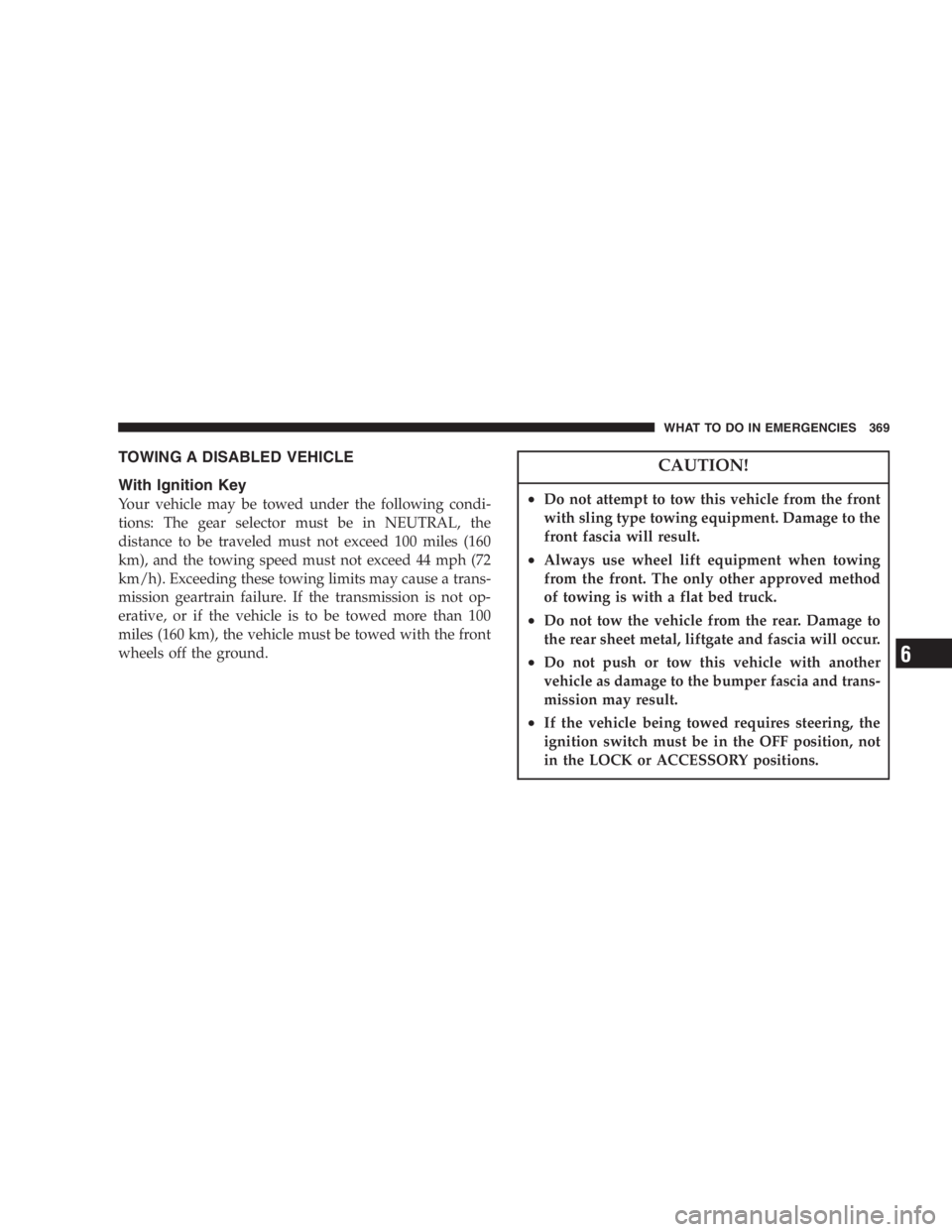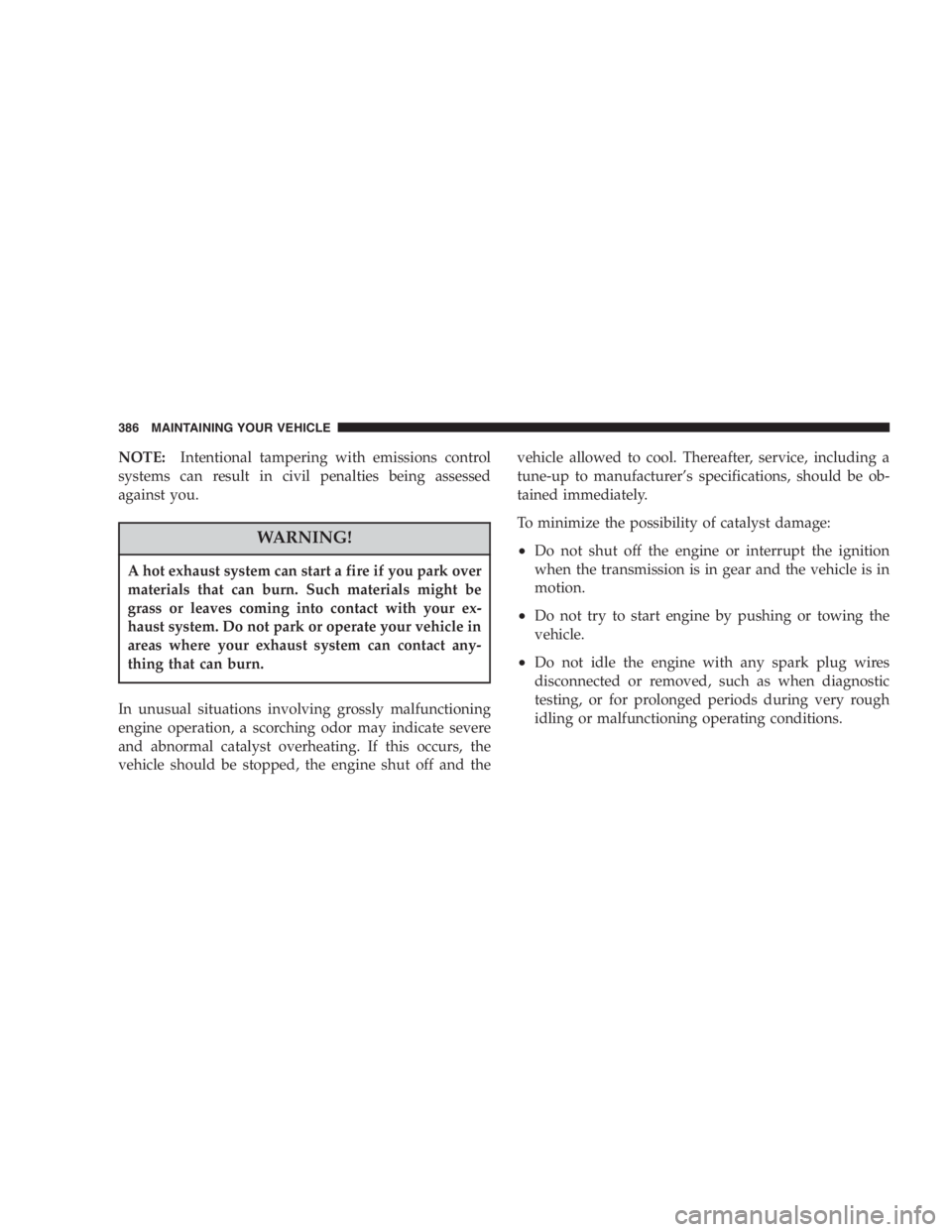Page 339 of 480

• The tongue weight of the trailer.
• The weight of any other type of cargo or equipment
put in or on your vehicle.
• Remember that everything put in or on the trailer adds
to the load on your vehicle.
Tongue weight must be equal to at least 10% of Gross
Trailer Weight (GTW), but no more than 15% of GTW.
Towing Requirements
• The maximum frontal area of the trailer cannot exceed
40 square feet (3.72 square meters).
• The trailer tongue load must be considered as part of
the combined weight of occupants and cargo, and
should never exceed the weight referenced on the Tire
and Loading Information placard. Refer to the Tire –
Safety Information Section in this manual.
• The “ D ” range can be selected when towing. However,
if frequent shifting occurs while in this range, the “ 3 ”
range must be selected. NOTE: Using the “ 3 ” range while operating the vehicle
under heavy operating conditions will improve perfor-
mance and extend transaxle life by reducing excessive
shifting and heat build up.
• Do not attempt to tow a trailer while using a compact
spare tire.
• Whenever you pull a trailer, regardless of the trailer
size, stop lights and turn signals on the trailer are
recommended for motoring safety.
• The automatic transaxle fluid and filter should be
changed if you REGULARLY tow a trailer for more
than 45 minutes of continuous operation. See Schedule
“ B ” in section 8 of this manual for transaxle fluid
change intervals.
NOTE: Check the automatic transaxle fluid level before
towing. STARTING AND OPERATING 339
5
Page 341 of 480
A load equalizing hitch is recommended for loaded
trailer weights above 1,000 lbs (454 kg) and required for
weights above 2,000 lbs (907 kg).
Special care should be taken when towing a trailer with
heavy duty trailer tow package, without a load equaliz-
ing hitch, and with 6 to 7 passengers, to insure the rear
GAWR is not exceeded. Depending on your vehicle
model and options, the maximum trailer weight could
range from 0 to 2000 pounds.
CAUTION!If the trailer weighs more than 1,000 lbs (454 kg)
loaded, it should have its own brakes and they
should be of adequate capacity. Failure to do this
could lead to accelerated brake lining wear, higher
brake pedal effort, and longer stopping distances. WARNING!Connecting trailer brakes to your vehicle ’ s hydraulic
brake lines can overload your brake system and
cause it to fail. You might not have brakes when you
need them and could have an accident. STARTING AND OPERATING 341
5
Page 343 of 480
WHAT TO DO IN EMERGENCIESCONTENTS � Hazard Warning Flasher ..................344
� If Your Engine Overheats .................345
� Jacking And Tire Changing ................346
▫ Jacking Instructions — Fold-In-Floor Seating . . 347
▫ Jacking Instructions — Non Fold-In-Floor
Seating .............................359
� Jump-Starting Procedures If Battery Is Low ....365
� Driving On Slippery Surfaces ..............367
▫ Acceleration .........................367 ▫ Traction ............................367
� Freeing A Stuck Vehicle ..................368
� Towing A Disabled Vehicle ................369
▫ With Ignition Key .....................369
▫ Without The Ignition Key ...............370
▫ Towing This Vehicle Behind Another Vehicle
(Flat Towing With All Four Wheels On The
Ground) ............................370
▫ Towing This Vehicle Behind Another Vehicle
With A Tow Dolley ....................370
6
Page 369 of 480

TOWING A DISABLED VEHICLE
With Ignition Key
Your vehicle may be towed under the following condi-
tions: The gear selector must be in NEUTRAL, the
distance to be traveled must not exceed 100 miles (160
km), and the towing speed must not exceed 44 mph (72
km/h). Exceeding these towing limits may cause a trans-
mission geartrain failure. If the transmission is not op-
erative, or if the vehicle is to be towed more than 100
miles (160 km), the vehicle must be towed with the front
wheels off the ground. CAUTION!• Do not attempt to tow this vehicle from the front
with sling type towing equipment. Damage to the
front fascia will result.
• Always use wheel lift equipment when towing
from the front. The only other approved method
of towing is with a flat bed truck.
• Do not tow the vehicle from the rear. Damage to
the rear sheet metal, liftgate and fascia will occur.
• Do not push or tow this vehicle with another
vehicle as damage to the bumper fascia and trans-
mission may result.
• If the vehicle being towed requires steering, the
ignition switch must be in the OFF position, not
in the LOCK or ACCESSORY positions. WHAT TO DO IN EMERGENCIES 369
6
Page 370 of 480
If it is necessary to use the accessories while being towed
(wipers, defrosters, etc.), the key must be in the ON
position, not the ACCESSORY position. Make certain the
transmission remains in NEUTRAL.
Without The Ignition Key
Special care must be taken when the vehicle is towed
with the ignition in the LOCK position. The only ap-
proved method of towing with out the ignition key is
with a flat bed truck. Proper towing equipment is neces-
sary to prevent damage to the vehicle.
TOWING THIS VEHICLE BEHIND ANOTHER
VEHICLE (Flat towing with all four wheels on the
ground)
Flat towing of vehicles equipped with an automatic
transmission, is only permitted within the limitations
described in this section. TOWING THIS VEHICLE BEHIND ANOTHER
VEHICLE WITH A TOW DOLLEY
The manufacture does not recommend that you tow a
front wheel drive vehicle on a tow dolley. Vehicle damage
may occur.370 WHAT TO DO IN EMERGENCIES
Page 376 of 480

ONBOARD DIAGNOSTIC SYSTEM — OBD II
Your vehicle is equipped with a sophisticated onboard
diagnostic system called OBD II. This system monitors
the performance of the emissions, engine, and automatic
transmission control systems. When these systems are
operating properly, your vehicle will provide excellent
performance and fuel economy, as well as engine emis-
sions well within current government regulations.
If any of these systems require service, the OBD II system
will turn on the “ Malfunction Indicator Light. ” It will
also store diagnostic codes and other information to
assist your service technician in making repairs. Al-
though your vehicle will usually be drivable and not
need towing, see your dealer for service as soon as
possible. CAUTION!• Prolonged driving with the “ Malfunction Indica-
tor Light ” on could cause further damage to the
emission control system. It could also affect fuel
economy and driveability. The vehicle must be
serviced before any emissions tests can be per-
formed.
• If the “ Malfunction Indicator Light ” is flashing
while the engine is running, severe catalytic con-
verter damage and power loss will soon occur.
Immediate service is required.376 MAINTAINING YOUR VEHICLE
Page 381 of 480

Change Engine Oil
Road conditions and your kind of driving affects the
interval at which your oil should be changed. Check the
following list to see if any apply to you.
• Day or night temperatures are below 32 ° F(0 ° C).
• Stop and Go driving.
• Extensive engine idling.
• Driving in dusty conditions.
• Short trips of less than 10 miles (16 km).
• More than 50% of your driving is at sustained high
speeds during hot weather, above 90 ° F (32 ° C).
• Trailer towing.
• Taxi, Police or delivery service (commercial service).
• Off-Road or desert operation. If ANY of these apply to you, then change your engine oil
at every interval shown in schedule “ B ” of the “ Mainte-
nance Schedules ” section of this manual.
If none of these apply to you, then change your engine oil
at every interval shown on schedule “ A ” of the “ Main-
tenance Schedules ” section of this manual
NOTE: Under no circumstances should oil change in-
tervals exceed 6000 miles (10 000 km) or 6 months
whichever comes first.
Engine Oil Selection
For best performance and maximum protection under all
types of operating conditions, the manufacturer only
recommends engine oils that are API certified and meet
the requirements of DaimlerChrysler Material Standard
MS-6395. MAINTAINING YOUR VEHICLE 381
7
Page 386 of 480

NOTE: Intentional tampering with emissions control
systems can result in civil penalties being assessed
against you.
WARNING!A hot exhaust system can start a fire if you park over
materials that can burn. Such materials might be
grass or leaves coming into contact with your ex-
haust system. Do not park or operate your vehicle in
areas where your exhaust system can contact any-
thing that can burn.
In unusual situations involving grossly malfunctioning
engine operation, a scorching odor may indicate severe
and abnormal catalyst overheating. If this occurs, the
vehicle should be stopped, the engine shut off and the vehicle allowed to cool. Thereafter, service, including a
tune-up to manufacturer ’ s specifications, should be ob-
tained immediately.
To minimize the possibility of catalyst damage:
• Do not shut off the engine or interrupt the ignition
when the transmission is in gear and the vehicle is in
motion.
• Do not try to start engine by pushing or towing the
vehicle.
• Do not idle the engine with any spark plug wires
disconnected or removed, such as when diagnostic
testing, or for prolonged periods during very rough
idling or malfunctioning operating conditions.386 MAINTAINING YOUR VEHICLE